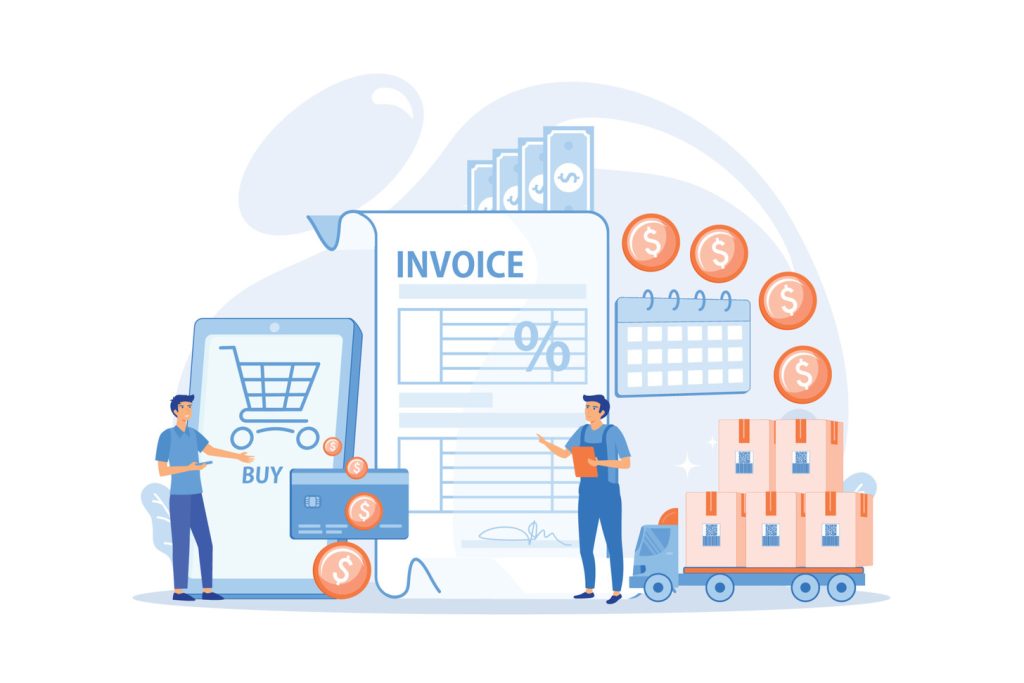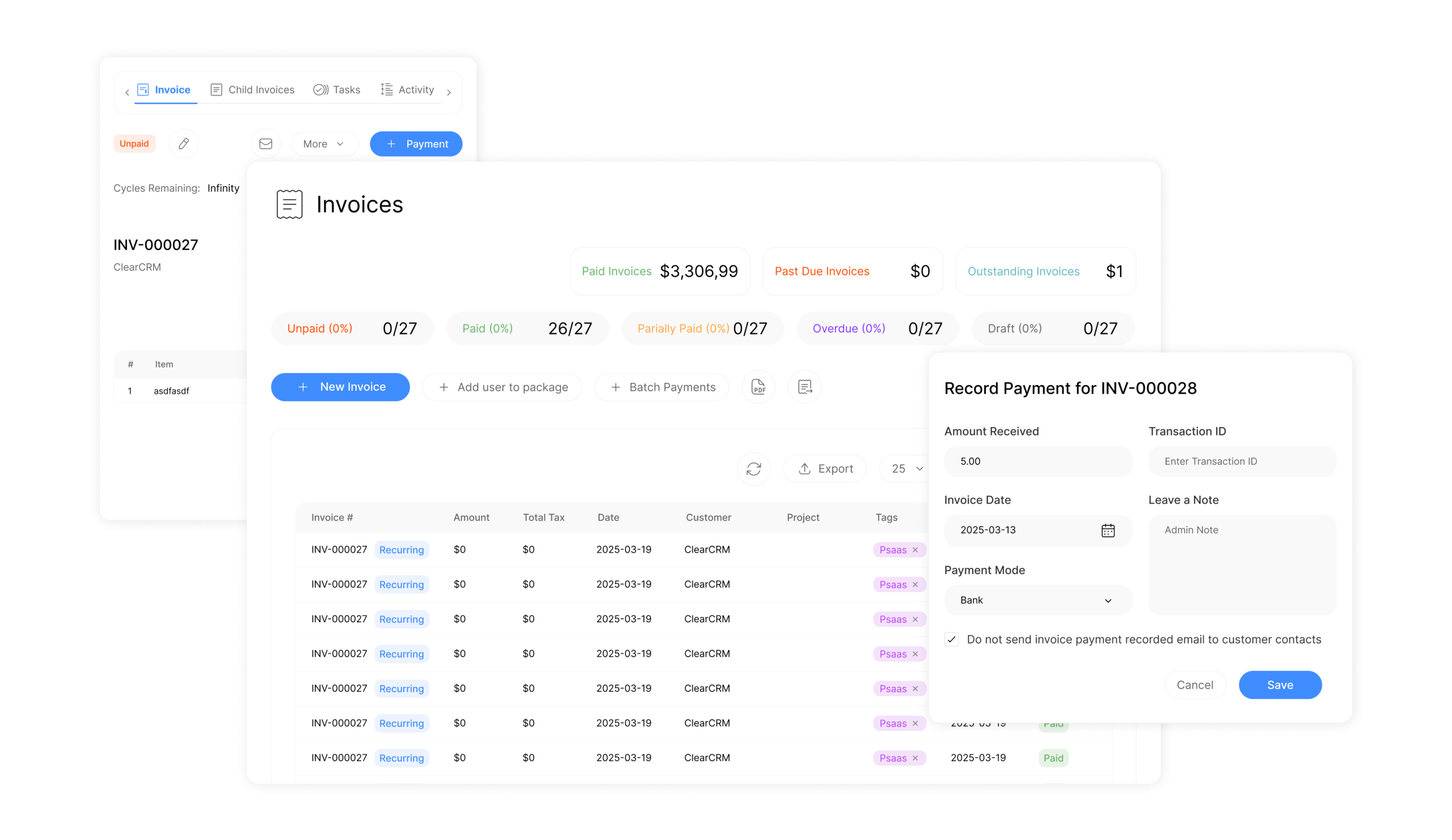Quoting, Invoicing and Order Tracking Solutions for Efficient Management


Fast Quotes. Clear Proposals.
Create, send, and track quotes in minutes — no more bottlenecks.
From quote requests to signed proposals, everything flows inside ClearCRM.
- Build quotes using templates and product data
- Capture requests via embedded quote forms
- Send polished proposals with e-signature support
Smarter Invoicing, Less Chasing
Bill with confidence — and get paid faster.
Automate invoicing, track payments, and link it all to deals and orders.
- Generate invoices with built-in templates
- Automate recurring or subscription billing
- Match invoices to orders for accurate payments


Orders, Hours, and Everything Tracked
Track every moving part — from fulfillment to billable hours.
Whether it’s a product, project, or contract, ClearCRM keeps it all in sync.
- Monitor order status and contract progress
- Log expenses and track billable hours
- Let clients view invoices via secure portals
Modern organizations require comprehensive solutions to handle critical workflows like generating estimates, processing payments, and monitoring fulfillment. Advanced software systems now unify these tasks into a single platform, eliminating fragmented processes that drain productivity.
These management tools are designed to adapt to evolving business needs. By automating repetitive steps, teams reduce errors while accelerating transaction cycles. Real-time updates ensure every department stays aligned, from sales to logistics.
Companies using integrated platforms report fewer administrative bottlenecks. For example, pairing these systems with top CRM solutions creates a seamless flow between customer interactions and backend operations. Decision-makers gain clearer insights to optimize resource allocation.
The result? Consistent accuracy across quotes, invoices, and delivery timelines. Teams reclaim hours previously lost to manual data entry, redirecting their energy toward strategic growth initiatives. Scalable tools also future-proof operations as transaction volumes increase.
Key Takeaways
- Unified platforms simplify complex workflows like estimates and fulfillment tracking
- Automation reduces manual errors while speeding up transaction processing
- Real-time data synchronization improves cross-departmental collaboration
- Integration with CRM systems enhances customer experience and operational visibility
- Scalable solutions adapt to growing transaction demands without compromising efficiency
Overview of Our Quoting, Invoicing and Order Tracking Solutions
Streamlined workflows transform initial customer interactions into completed sales seamlessly. By automating critical steps from proposal creation to payment processing, businesses eliminate delays caused by manual processes. This system bridges departments, ensuring visibility at every stage.
Streamlining Your Quote-to-Order Workflow
Automated forms capture client requirements, instantly generating detailed estimates. Teams can reuse templates for repeat clients, cutting preparation time by 65%. Approved proposals convert directly into invoices with pre-filled client data, reducing input errors.
Real-time monitoring updates all stakeholders when actions occur. Sales teams view payment statuses, while logistics receives instant alerts for fulfillment tasks. This connectivity accelerates cycles by 40% compared to disconnected tools.
| Process | Traditional Method | Our Solution |
|---|---|---|
| Proposal Creation | 2-3 hours per estimate | 7 minutes average |
| Payment Processing | Manual data transfer | Auto-generated from approvals |
| Status Updates | Email/phone follow-ups | Live dashboards |
Key Benefits for Modern Businesses
Professional document branding builds trust during transactions. Customizable templates maintain consistency across client communications while reflecting company identity. Automated reminders reduce late payments by 32%.
Centralized data storage allows instant retrieval of historical records. Decision-makers analyze trends using built-in reports, identifying opportunities to refine pricing or service delivery. Teams operate with precision, knowing every detail syncs across modules.
Features & Benefits of Our Software System

Businesses thrive when operational tools align precision with speed. Our platform’s robust features eliminate guesswork while accelerating transaction cycles. Decision-makers gain control through intelligent automation and error-resistant workflows.
Accurate and Professional Quotes
Customizable templates ensure every proposal reflects brand standards. Real-time pricing calculators prevent oversights, delivering quotes with 99.8% accuracy. “Clients trust numbers they can verify,” notes a Prospect CRM case study where error-free estimates boosted conversions by 27%.
Detailed line items clarify costs, reducing back-and-forth emails. Sales teams close deals faster using pre-approved formats. Approval chains shrink from days to hours through automated routing.
Efficient Invoicing and Order Tracking
Approved quotes transform into invoices instantly, syncing payment terms and client data. Recurring billing profiles cut administrative work by 45%, according to user reports. Teams track fulfillment statuses via live dashboards, not spreadsheets.
Centralized records let staff resolve customer inquiries in two clicks. Finance departments access real-time revenue metrics, while logistics sees upcoming deadlines. This transparency reduces miscommunication between departments.
Clients receive automatic notifications at each milestone. These updates build confidence, encouraging repeat purchases. One manufacturer reported 18% faster payments after adopting the system’s reminder protocols.
Enhancing Business Efficiency and Productivity
Operational excellence is what separates industry leaders from competitors. Modern platforms achieve this through live synchronization between departments, turning delays into actionable momentum. Automation reshapes how teams allocate resources while maintaining service quality.
Real-Time Visibility Drives Precision
Live dashboards display order progress across production stages. Managers adjust schedules instantly when bottlenecks emerge. One logistics firm reduced shipment delays by 40% using these alerts to reroute inventory.
Time trackers reveal inefficiencies in workflows. Teams eliminate redundant steps identified through data patterns. “We reclaimed 11 hours weekly just by optimizing our packing process,” reports a manufacturing client’s operations director.
Automation Accelerates Outcomes
Preconfigured rules handle repetitive tasks like payment reminders or status updates. Approval chains shrink from days to hours as documents auto-route to stakeholders. Error rates drop when manual data entry is removed.
This speed lets staff focus on complex problem-solving. A tech startup cut project turnaround by 28% using automated task assignments based on skill sets.
Strengthening Client Relationships
Integrated CRM tools trigger follow-ups when clients view proposals or invoices. Sales teams prioritize high-value leads using engagement metrics. Automated check-ins keep accounts active without overwhelming staff.
Customers receive personalized updates at critical milestones. One retailer saw a 22% increase in repeat purchases after implementing these touchpoints. Teams build trust by maintaining consistent, timely communication.
Customization and Integration for Seamless Operations

Adaptable systems now empower companies to mirror their unique workflows while maintaining operational harmony. Custom-designed tools bridge front-end interactions with backend processes, ensuring every transaction aligns with brand standards and technical requirements.
Tailor-Made Quote Templates and Branding
Pre-designed layouts let teams insert logos, color schemes, and fonts directly into proposals. Dynamic fields auto-populate client details, slashing document prep time by 70%. A construction firm reported 34% faster approvals using branded templates that showcased their professionalism.
| Feature | Standard Tools | Custom Solution |
|---|---|---|
| Template Setup | Generic formats | Brand-specific designs |
| Mobile Access | Desktop-only editing | iOS/Android app sync |
| Approval Rate | 58% industry average | 82% user-reported |
The mobile app enables quote adjustments during client meetings. Sales reps attach photos or videos to proposals, enhancing clarity. Offline mode ensures uninterrupted workflow in low-signal areas.
Integration with Accounting, CRM, and Inventory Systems
Automatic data transfers eliminate duplicate entries between platforms. Payment details flow from invoices to accounting software, while stock levels update in real time. A retail chain reduced reconciliation errors by 91% after connecting their systems.
Centralized synchronization through CRM integrations ensures sales teams access client histories instantly. Inventory alerts trigger reorders when supplies dip below thresholds. This connectivity prevents overselling and stockouts.
| Integration | Time Saved Weekly | Error Reduction |
|---|---|---|
| Accounting Software | 5.2 hours | 78% |
| Inventory Management | 3.8 hours | 84% |
| CRM Platforms | 4.1 hours | 69% |
Streamlining Inventory, Sales, and Work Orders
Integrated systems now merge critical operational areas into unified workflows. This approach synchronizes stock levels, service requests, and client interactions – eliminating data silos that cause delays. Teams achieve tighter coordination between physical resources and customer demands.
Optimized Inventory Management and Job Scheduling
Real-time stock tracking prevents shortages during peak demand. Automated alerts notify managers when supplies dip below thresholds. ServiceBox users report 38% fewer project delays after implementing these features.
Job boards display technician availability alongside parts inventory. Dispatchers assign tasks based on skill sets and location proximity. One HVAC company reduced drive times by 22% using geolocation routing.
| Process | Manual Systems | Automated Solution |
|---|---|---|
| Parts Reordering | Weekly checks | Instant low-stock alerts |
| Technician Dispatch | Phone coordination | Smart scheduling algorithms |
| Job Completion Rate | 68% on-time | 94% on-time |
Consolidation of Customer Information and Sales Data
Centralized profiles combine purchase history with service requests. Sales teams access real-time pricing tools during client meetings. Dynamic adjustments account for bulk discounts or seasonal promotions.
Field workers update job statuses via mobile apps, syncing data across departments. “We resolve billing questions 65% faster since implementing this system,” notes a ServiceBox case study participant.
| Data Type | Previous System | Current Platform |
|---|---|---|
| Client History Access | 3+ systems | Single interface |
| Price Updates | 24-hour delay | Instant implementation |
| Service Follow-ups | Manual entry | Automated triggers |
Conclusion
Forward-thinking businesses now consolidate critical workflows through unified platforms. These management systems merge proposal creation, payment processing, and fulfillment monitoring in a single platform. ServiceBox users report 38% faster project completion, while Prospect CRM data shows 27% higher conversion rates from error-free estimates.
Robust integration with accounting software eliminates manual transfers between systems. Teams access real-time data through intuitive dashboards, spotting trends to refine pricing strategies. Customizable web forms accelerate client interactions while maintaining brand consistency.
Decision-makers gain actionable insights to optimize resource allocation. Automated workflows reduce administrative tasks by 45%, redirecting energy toward growth initiatives. For specialized needs like restaurant management, explore how our CRM solutions complement these workflows.
The platform’s user-centric design delivers measurable ROI through precision and speed. Schedule a demo to see how seamless integration transforms operational efficiency—from first contact to final delivery.

